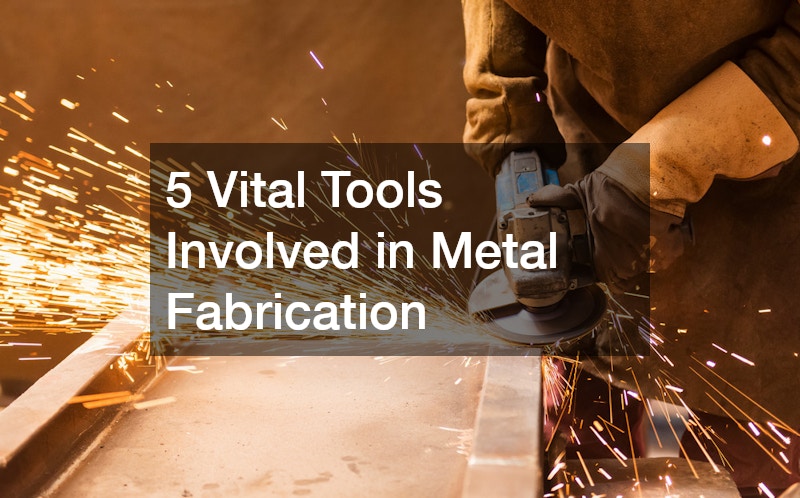Metal fabrication is an essential process in various industries, from automotive and aerospace to construction and manufacturing. This craft involves shaping, cutting and assembling metal to create a wide range of products, from simple components to complex structures. The process relies heavily on specific tools that not only ensure precision but also increase efficiency and safety.
Below, we will explore the vital tools involved in metal fabrication and how they contribute to the overall fabrication process.
1. Metal Cutting Tools
One of the primary steps in metal fabrication is cutting. To cut metal accurately and efficiently, metal fabricators rely on several tools:
- Band Saws: Band saws are commonly used to cut through metal sheets and rods. With their continuous blade, they are well-suited for both straight and curved cuts. These saws provide a clean cut and can handle a variety of materials, including steel, aluminium and brass.
- Plasma Cutters: Plasma cutting tools are vital for cutting thicker metals. They work by using ionised gas to melt and blow away the metal at the cutting point. Plasma cutters offer fast cutting speeds and are perfect for cutting through high-density materials.
- Laser Cutters: For more intricate designs, laser cutters are essential. These devices use high-powered lasers to cut through metal with incredible precision. Laser cutters are often used in industries where tight tolerances and complex shapes are required, such as in the aerospace and electronics sectors.
2. Welding Equipment
Welding is a crucial process in metal fabrication, as it involves joining metal pieces together to form a solid structure. Various welding tools are used depending on the specific needs of the project:
- MIG Welders (Metal Inert Gas): MIG welding is one of the most common methods in metal fabrication. It uses a continuously feeding wire as the electrode and an inert gas to protect the weld from contamination. This process is efficient, offering fast weld speeds and is suitable for a wide range of metals, including stainless steel and aluminium.
- TIG Welders (Tungsten Inert Gas): For projects requiring higher precision and cleaner welds, TIG welding is preferred. It uses a non-consumable tungsten electrode and an inert gas to protect the weld. TIG welding is ideal for thin metals and is often used in industries such as automotive, aircraft and medical devices.
- Stick Welders: Stick welding, also known as Shielded Metal Arc Welding (SMAW), is one of the oldest welding techniques. It is a versatile method that works well on thicker materials and in outdoor environments. Stick welders are ideal for fabrication work in construction or shipbuilding.
3. Metal Bending and Forming Tools
Once the metal is cut, bending and forming are the next steps in shaping the material. Several tools are designed to ensure precise bends and curves in metal fabrication:
- Press Brakes: Press brakes are used to bend sheets of metal into specific angles or shapes. They come in various sizes and can handle everything from light gauge sheet metal to heavy steel plates. The machine uses a die and a punch to apply force, ensuring consistent and accurate bends.
- Rollers: Rollers are employed to shape metal into curves and circles. These tools are particularly useful in metal fabrication when working with pipes or large metal sheets that need to be bent to a specific radius. Rollers work by gradually bending the metal in a controlled manner.
- Hydraulic Benders: Hydraulic benders provide a more powerful means of bending metal. The machine uses hydraulic pressure to bend the material with greater force and precision. These tools are invaluable for large-scale fabrication projects requiring consistent bends over a large volume of materials.
4. Grinding and Polishing Tools
Grinding and polishing are essential steps in the finishing process of metal fabrication. These tools help smooth out surfaces, remove excess material and prepare the metal for further treatment or painting:
- Angle Grinders: Angle grinders are handheld tools used for grinding, cutting and polishing metal. They are versatile and efficient, ideal for deburring edges, smoothing welds or removing rust and paint.
- Belt Sanders: Belt sanders use a rotating abrasive belt to smooth out rough edges on metal. These tools are used for larger surfaces and are typically employed after welding to ensure a clean and even finish.
- Polishers: Metal polishers are used to give metal surfaces a shiny, smooth finish. These tools are often used in the final stages of metal fabrication, especially for items that require an aesthetically pleasing surface, such as decorative elements or high-quality products.
5. Measuring and Inspection Tools
Precision is paramount in metal fabrication, and accurate measurements are crucial to ensuring that the final product meets the required specifications. Various measuring and inspection tools are used throughout the process:
- Calipers: Digital and vernier calipers are essential tools for measuring the thickness, diameter and overall dimensions of metal pieces. These tools provide high accuracy and are widely used in metal fabrication shops.
- Micrometres: Micrometres are used for measuring small dimensions with incredible precision. These tools are vital when working with small components or for ensuring that thin sheets of metal meet exact specifications.
- Levels and Squares: To ensure that metal pieces are aligned correctly during the assembly and welding stages, fabricators rely on levels and squares. These tools help ensure straight edges and right angles, which are essential for structural integrity.
The process of metal fabrication is complex and requires a range of tools to perform tasks like cutting, welding, bending, grinding and measuring. Each tool has a specific role in ensuring that the metal is shaped and joined correctly, with precision and efficiency. By understanding the vital tools involved in metal fabrication, you can appreciate the skill and technology required to turn raw metal into useful products across various industries. Whether you are a seasoned fabricator or someone interested in the craft, knowing these tools is essential for mastering the art of metal fabrication.
.

